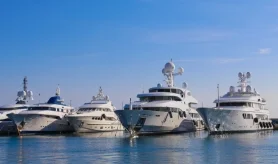- Alaskan Yachts
- Azimut Yachts
- Back Cove Yachts
- Beneteau Yachts
- Benetti Superyachts
- Bertram Yachts
- Boston Whaler
- Broward Yachts
- Buddy Davis Sportfish
- Burger Yachts
- Cabo Yachts
- Catamarans
- Carver Motoryachts
- Center Console
- Chris-Craft Yachts
- Cruisers Yachts
- DeFever Trawlers
- Dufour Sailboats
- Fairline Yachts
- Feadship Yachts
- Ferretti Yachts
- Formula Yachts
- Fountaine Pajot Cats
- Grady-White
- Grand Banks Trawlers
- Hargrave Yachts
- Hatteras Yachts
- Hinckley Picnic Boats
- Horizon Yachts
- Hydra-Sports
- Intrepid Boats
- Jarrett Bay Sportfish
- Jeanneau Yachts
- Kadey-Krogen Trawlers
- Lazzara Yachts
- Lekker Boats
- Luhrs Sportfish
- Marlow Yachts
- Maritimo Yachts
- Marquis Yachts
- McKinna Motoryachts
- Meridian Yachts
- Midnight Express
- MJM Yachts
- Mochi Craft
- Neptunus Motoryachts
- Nordhavn Trawlers
- Nordic Tugs
- Numarine Yachts
- Ocean Alexander Yachts
- Offshore Yachts
- Outer Reef
- Oyster Sailing Yachts
- Pacific Mariner Yachts
- Palmer Johnson Yachts
Coral Reef Restoration: The Coral Fanfare
Coral reefs host a quarter of the Earth’s marine biodiversity, but the planet has already lost half of them over the past three decades and more than 90 percent could become extinct by 2050. So, what’s the plan?
In 2007, a team of scientists from the Coral Restoration Foundation in Florida began outplanting staghorn coral colonies to reefs in the Florida Keys. The area, once abundant with the stony coral variety, has seen populations decline since the 1970s. In fact, staghorn coral populations around the world have dropped by more than 80 percent over the past 30 years, and it’s a similar story with many other coral species. The main causes are disease and global warming, especially higher ocean temperatures and ocean acidification. So, what now? Are coral capable of recovering in the wild or are restoration projects our only hope?
Dr. Ellen Prager, a marine scientist who has participated in research expeditions to the Galapagos Islands, Papua New Guinea, the Caribbean, the Bahamas and the deep waters of the Florida Reef tract believes that in cases of acute damage, such as ship groundings, effective restoration practices have merit. But she counters this positivity with science-based reasoning that restoration efforts only work for a short time.
“Success cannot be based on how many corals are planted, but on long-term survival and growth. We cannot rely on restoration efforts if the underlying environment is not healthy for coral growth,” she told FRANK, citing climate change, pollution, overfishing and invasive species as examples of unhealthy conditions.

“There is no doubt the system is still capable of recovering itself and quite quickly.”
The Coral Restoration Foundation’s eight-year program looked at 20 coral outplanting projects measuring the survivorship, growth and condition of 2,419 colonies. The researchers concluded that beyond seven years the estimated survivorship is less than ten percent. On the face of it, that reads like a rather bleak conclusion. However, they also reported that by repeatedly outplanting large numbers of nursery-raised colonies, coral populations can be maintained and even increased until external stressors (such as climate change) are mitigated. In the eyes of the researchers, this is the very definition of a long-term commitment to restoration.
Across the pond in Australia, the Great Barrier Reef Foundation is focused on rescuing the world’s biggest coral reef system off the coast of Queensland. Its three-pronged attack involves cooling and shading, assisting reef species to evolve and adapt to changing environments, and supporting the natural restoration of damaged and degraded reefs. One of the foundation’s leading techniques, dubbed ‘coral IVF’, has successfully pioneered small-scale coral restoration by capturing the coral eggs and sperm from healthy reefs to rear millions of baby corals in customized enclosures on the reef and in tanks. These baby corals are then delivered onto small areas of damaged reefs to restore and repopulate them.
Another angle gaining traction is the attempt to genetically engineer heat-resistant coral. Researchers from Australia’s national scientific agency CSIRO claim to have made coral more resilient to temperature-induced bleaching by bolstering the heat tolerance of its microalgal symbionts – the tiny cells of algae that live inside the coral tissue.
Dr. Andy Lewis, founder of the Coral Sea Foundation in Australia, is cynical about both options: “Coral farming projects can be used to help restore very small areas, but the Great Barrier Reef is over 1,200 miles long with 3,000 reefs so the best way to encourage recovery is to give the natural system the best chance of doing the job itself.”
In place of programs, Dr. Lewis advocates well-managed protected areas, effective supervision of the nutrients and other pollutants coming off the mainland and continuing the push for hard cuts to carbon emissions. “There is no doubt the system is still capable of recovering itself and quite quickly,” he says, citing the natural density of baby corals on a reef at Lizard Island as evidence. “They are now approaching 20 to 30 per square meter, and this was a reef that was totally devoid of coral life in 2016 after two major cyclones and a bleaching event.”
“The rise in submersible access has meant swathes of black coral have been found in the Mediterranean.”
Dr. Lewis is not alone in his positivity. In 2019, the heartwarming discovery of two rare and endangered corals was made in the marine-rich waters that surround the volcanic island of Ischia in the Gulf of Naples. A superyacht owner’s trip of a lifetime facilitated by Cookson Adventures gave researchers the opportunity to dive 820 feet in a submersible. They stumbled upon century-old colonies of red and black coral, which gave them incredible insight into what an undisturbed coral ecosystem looks like.
“The red coral that grows in the Mediterranean has been extracted by humans for thousands of years for commercial use, but most of that damage has occurred at diving depths of around 197 feet,” says Tim Burton, Cookson’s project manager. “What became apparent on the submersible trip is that at deeper depths there are actually very healthy populations. Likewise, black coral usually grows in tropical seas, but the rise in submersible access has meant big swathes of it have been found in the Mediterranean at depths of around 394 feet.”
In the Mesoamerican region lies the world’s second largest barrier reef system where some of the last healthy populations of critically endangered coral remain. The Pelorus Foundation, the charitable arm of the eponymous expedition company, is working with local communities to ensure the coral reefs in Honduras have enough fish to support a healthy marine ecosystem that will thrive for generations. In the Solomon Islands, a partner of Pelorus is helping to restore coral impacted by the damaging by-products of logging and development.
The ideal would be to once again attain self-sustaining coral populations, but until a time when external factors are no longer killing off coral the scientific recommendation is that restoration projects have an important role to play in the persistence and recovery of our vital coral reefs.
AROUND THE WORLD

01. Secore International, Mexico
In 2017, this foundation launched the Global Coral Restoration Program, which focuses heavily on seeding coral larvae on a supporting material. The foundation assists nature by producing millions of genetically unique coral larvae by collecting gametes during natural spawning events followed by in-vitro fertilization. Resulting coral settlers are placed back on the reef to increase the genetic diversity and resilience of natural populations.

02. Reef Rescuers, Seychelles
This is one of the world’s first large-scale coral reef restoration projects based in the protected marine area of Cousin Island Special Reserve. For over ten years, a ‘coral gardening’ technique has been restoring bleached corals by collecting fragments from healthy donor sites, growing them in underwater ‘nurseries’ and transplanting them to a degraded reef. Since 2010, 40,000 corals have been raised in underwater nurseries, of which over 24,000 were successfully transplanted covering the area of a football field.

03. Reefscapers, Maldives
Established in 2000, this independent marine consultancy developed a pioneering coral frame technique in 2005, which has been used to improve the general health of the natural coral reefs at island-based resorts in the region. Attached to the frames, the corals can grow at a rate of up to 10-15cm per year and are regularly monitored. This self-sustaining method of coral propagation has dramatically contributed to biodiversity and transforming the sandy sea bottom into thriving reefs.

04. Phuket Marine Biological Center, Thailand
For several decades, a coral restoration project at Koh Mai Thon has been making a serious improvement on reefs that were damaged in a storm in 1986. More than 30 types of coral were grown on artificial reefs when the project started in 1994, and marine biologist Dr. Nalinee Thongtham revealed in a statement that in general, coral restoration was not a difficult task to accomplish and didn’t require much investment.

05. PUR Project, Indonesia
Center The marine branch of this conservation initiative takes a holistic approach to community-led ecosystem management through restoring highly degraded coral ecosystems. At the time of writing, it had planted 4,779 corals on an artificial reef. The growth is aided by a technology called ‘Biorock’ which passes a low voltage current through the structures. This creates a solid limestone coating that makes the coral growth more resilient to pollution and climate change. The project, located on the northwest coast of Bali, is run by local farmers and fishermen who rely heavily on the natural biodiversity of the surrounding region.
Request a Copy [FRANK Issue 2]
From intelligent debate to cutting-edge science, and risky sports to surreal charter experiences, FRANK does not shy away from the awkward, controversial, or questionable details. Brazen at times, amusing in spirit, and always transparent in discussion, the focus is on discovering new angles and enjoying every minute. And, of course, always being ‘frank’ about the conclusions.

Request A Copy






